What is Strategic Change?
Strategic change significantly alters an organization’s overall direction, goals, structures, processes, or culture. The goal is to better align with objectives and respond to external or internal factors.

Table of contents
This type of change is typically long-term and fundamental, aiming to improve the organization’s performance, competitiveness, and adaptability in the face of evolving challenges and opportunities.
Various factors, including shifts in market conditions, technological advancements, changes in regulatory environments, or internal organizational challenges, can drive strategic change.
It often involves a deliberate and planned effort to reshape the organization’s strategy and operations, requiring careful consideration, analysis, and execution.
The implementation of strategic change may involve the following:
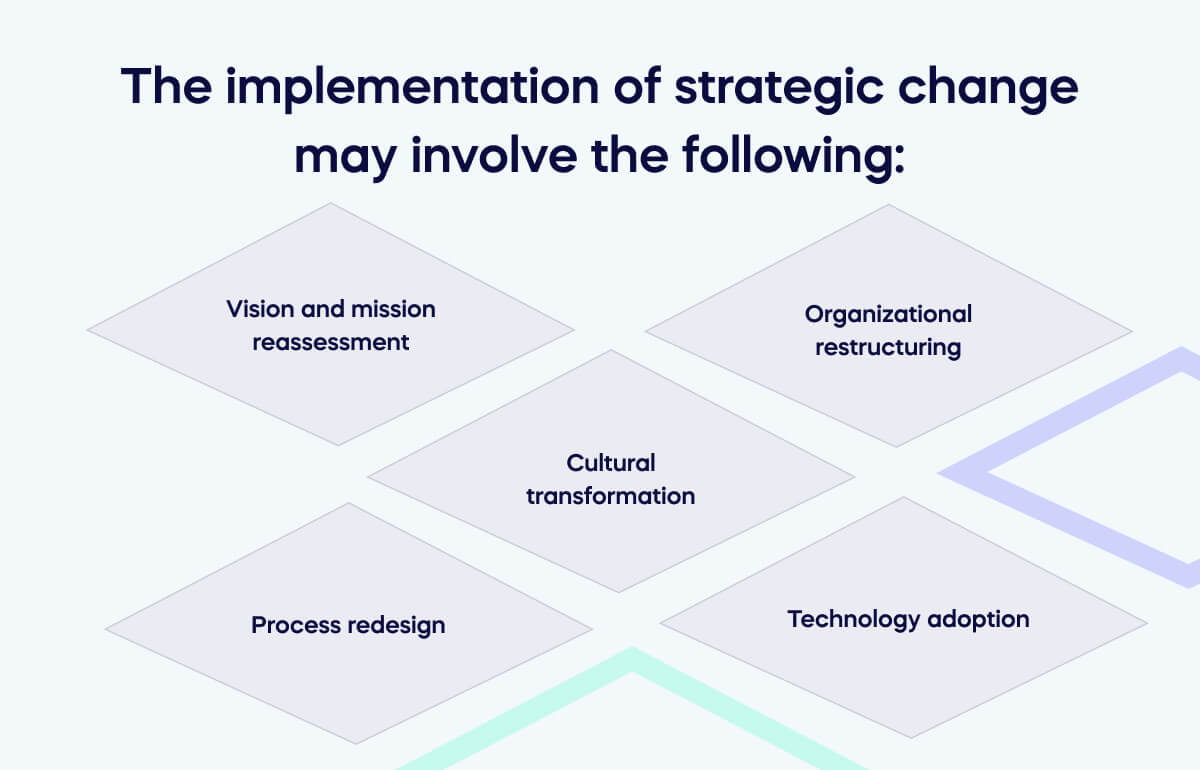
Vision and mission reassessment
Reevaluating the organization’s mission and vision to ensure they remain relevant and aligned with current and future goals.
Organizational restructuring
Adjusting the organizational structure to enhance efficiency, responsiveness, and collaboration.
Cultural transformation
Changing the organizational culture to foster innovation, adaptability, and a focus on customer needs.
Process redesign
Streamlining or reengineering existing processes to improve effectiveness and efficiency.
Technology adoption
Embracing new technologies or upgrading existing systems to stay competitive and meet evolving demands.
Successfully managing strategic change requires strong leadership, effective communication, employee engagement, and a well-thought-out change management plan.
It is essential to anticipate resistance, address concerns, and ensure all stakeholders are aligned and committed to the new direction.
Types of strategic change
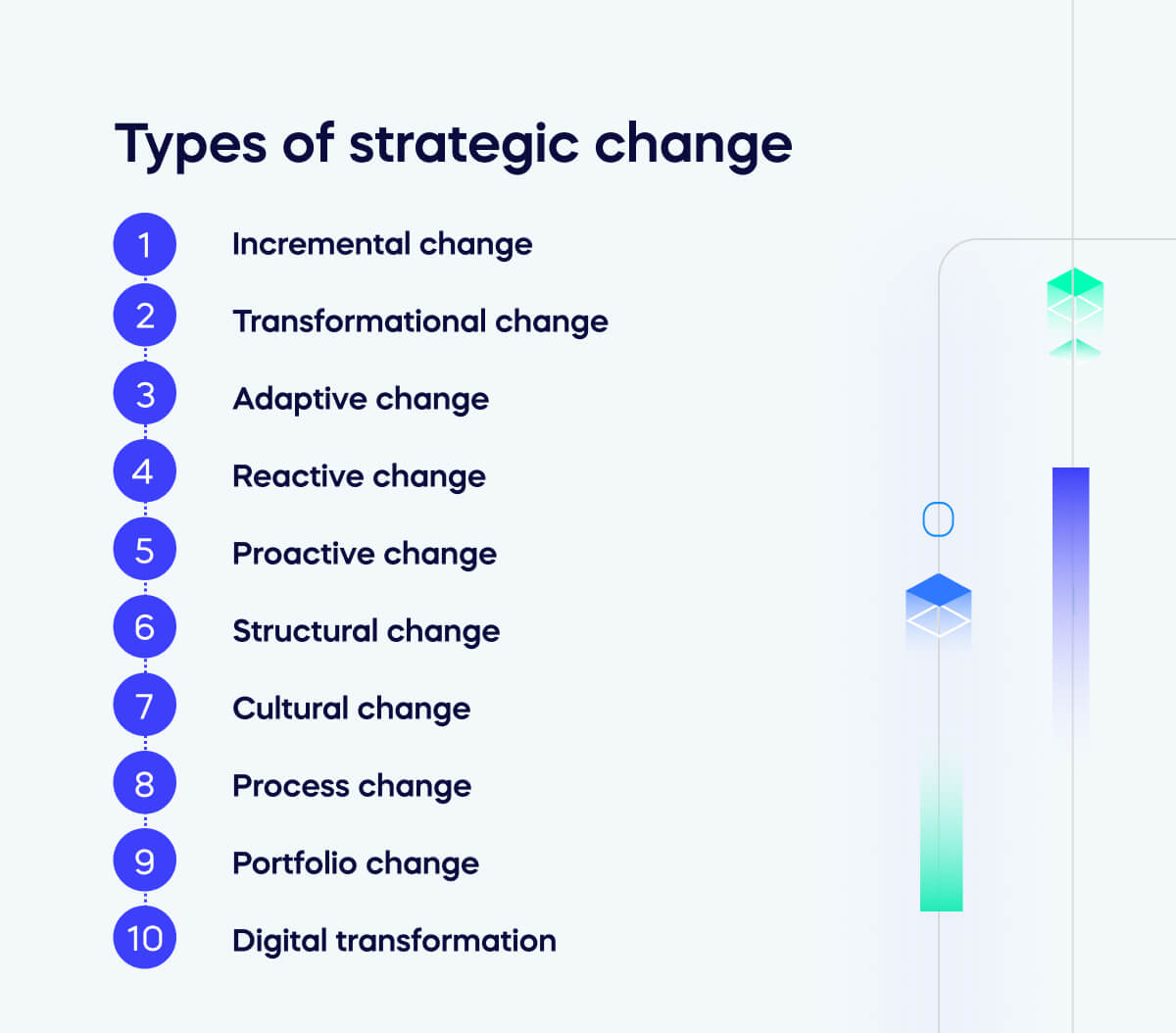
Strategic change can take various forms, and the specific type of change an organization pursues depends on its goals, challenges, and the context in which it operates.
Here are some common types of strategic change:
Incremental change
- Involves making small, gradual adjustments to existing processes, structures, or strategies.
- Often used when the organization seeks continuous improvement and wants to build on its current practices.
Transformational change
- Involves a fundamental and radical shift in the organization’s strategy, structure, culture, or processes.
- Aimed at achieving a significant and comprehensive change to address major challenges or capitalize on new opportunities.
Adaptive change
- Focuses on the organization’s ability to adapt to external changes, such as shifts in the market, technology, or regulatory environment.
- Involves flexibility and responsiveness to external factors.
Reactive change
- Occurs in response to crises or unexpected events that force the organization to make changes quickly.
- Often driven by the need to survive or address urgent issues.
Proactive change
- Initiates change in anticipation of future challenges or to capitalize on emerging opportunities.
- Reflects a strategic, forward-thinking approach to stay ahead of the competition or industry trends.
Structural change
- Involves alterations to the organization’s formal systems, processes, or hierarchy.
- Common examples include changes in reporting relationships, job roles, or departmental structures.
Cultural change
- Focuses on modifying the organization’s shared values, beliefs, and behaviors.
- Aims to create a more innovative, collaborative, or customer-centric culture.
Process change
- Concentrates on improving or redesigning specific business processes to enhance efficiency, quality, or innovation.
- Often involves the adoption of new technologies or methodologies.
Portfolio change
- Involves adjusting the mix of products, services, or business units in response to market dynamics or strategic goals.
- May include divestitures, acquisitions, or the introduction of new product lines.
Digital transformation
- Focuses on leveraging digital technologies to fundamentally alter how the organization operates, interacts with customers, and delivers value.
What triggers strategic change?
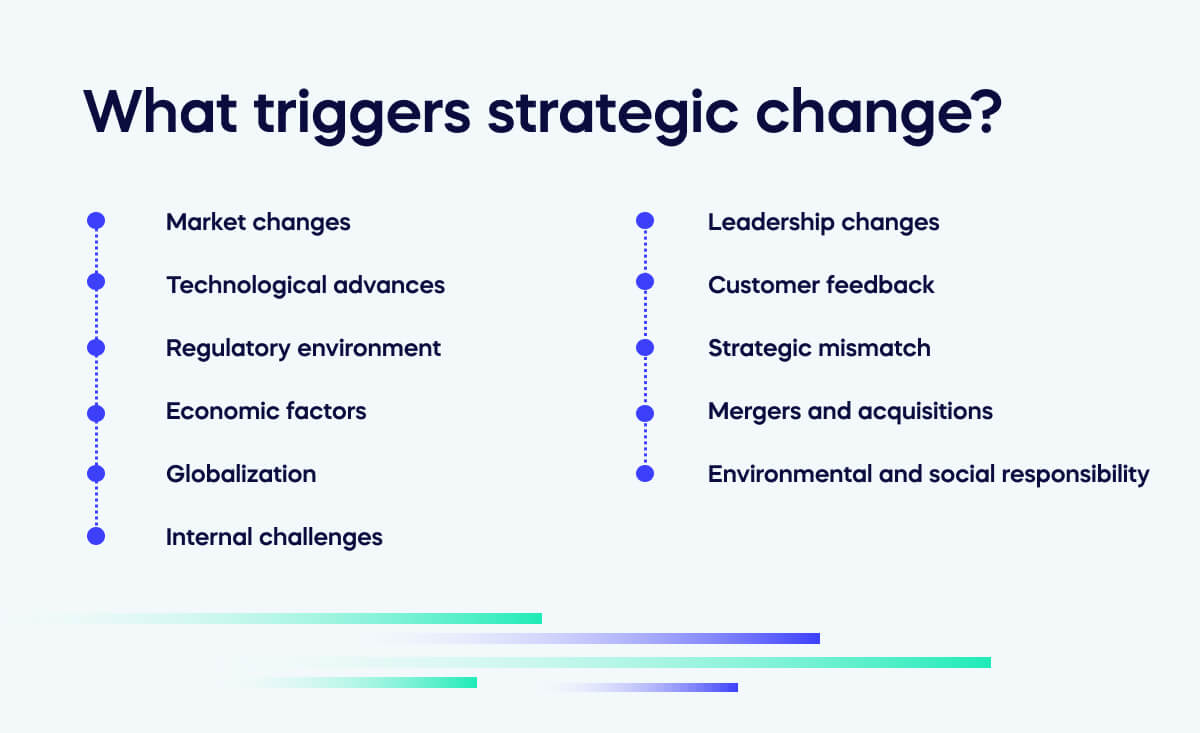
Several triggers can prompt an organization to initiate strategic change. These triggers are often external or internal factors that necessitate reassessing the current strategy or operations.
Some common triggers for strategic change include:
Market changes
- Shifts in customer preferences, behaviors, or demographics.
- Intense competition or the entry of new competitors.
- Changes in market demand for products or services.
Technological advances
- Rapid advancements in technology that impact the industry.
- Opportunities to adopt new technologies for improved efficiency or innovation.
- The emergence of disruptive technologies that alter the competitive landscape.
Regulatory environment
- Changes in government regulations or policies.
- New compliance requirements affecting business operations.
- Legal issues that necessitate adjustments to business practices.
Economic factors
- Economic downturns or recessions that impact consumer spending.
- Currency fluctuations or changes in interest rates.
Globalization
- Expansion into new international markets
- Changes in global economic conditions.
- Increased competition from international competitors.
- Opportunities to leverage global resources or partnerships.
Internal challenges
- Declining performance or financial difficulties.
- Inefficiencies in operations or outdated business processes.
- Employee dissatisfaction or high turnover rates.
Leadership changes
- Changes in top leadership, such as a new CEO or management team.
- A new organizational culture or leadership style.
Customer feedback
- Feedback from customers indicating dissatisfaction or changing needs.
- Opportunities to better align products or services with customer expectations.
Strategic mismatch
- Misalignment between the current strategy and the external environment.
- Recognition that the existing strategy is no longer effective or relevant.
Mergers and acquisitions
- Acquiring or merging with another company.
- Divesting or spinning off business units.
- Integration challenges following a merger or acquisition.
Environmental and social responsibility
- Growing emphasis on sustainability and environmental responsibility.
- Increasing consumer demand for socially responsible business practices.
Examples of strategic change
Examples of strategic change can vary widely depending on an organization’s specific context and goals.
Here are some illustrative examples across different industries and types of strategic change:
Digital transformation
A traditional brick-and-mortar retail company decides to undergo a digital transformation. It invests in e-commerce platforms, implements online sales channels, and utilizes data analytics to enhance customer experiences.
Cultural change
A technology company aims to foster a more innovative and collaborative culture. It introduces flexible work arrangements, encourages cross-functional teams, and establishes initiatives to recognize and reward creativity.
Mergers and acquisitions
A pharmaceutical company acquires a biotech startup to expand its product portfolio and gain access to innovative drug development technologies. The strategic change involves integrating the acquired company’s operations and aligning it with the overall corporate strategy.
Strategic alliance
Two automotive companies formed a strategic alliance to collaborate on the development of electric vehicles. This strategic change involves sharing resources, technologies, and expertise to address industry challenges and capitalize on emerging trends.
Process redesign
A manufacturing company adopts lean manufacturing principles to improve operational efficiency. This involves streamlining production processes, reducing waste, and optimizing the supply chain to enhance overall productivity.
Market repositioning
A software company initially focused on enterprise solutions decides to reposition itself to target small and medium-sized businesses. This strategic change involves adjusting marketing strategies, product features, and pricing to better suit the new target market.
Product diversification
A food and beverage company expands its product line to include healthier options in response to changing consumer preferences. This strategic change involves research and development efforts, marketing campaigns, and adjustments to distribution channels.
Cost leadership strategy
An airline company facing increased competition decides to implement a cost leadership strategy. This involves reducing operating costs through measures such as renegotiating supplier contracts, optimizing routes, and improving fuel efficiency.
Global expansion
A technology company expands its operations into emerging markets to tap into new customer bases. This strategic change involves adapting products to local preferences, navigating regulatory differences, and establishing a global supply chain.
Reactive change
A software company responds to security breaches by implementing a comprehensive cybersecurity strategy. This involves enhancing data protection measures, conducting regular audits, and educating employees on security best practices.
Big brands that have undergone strategic change
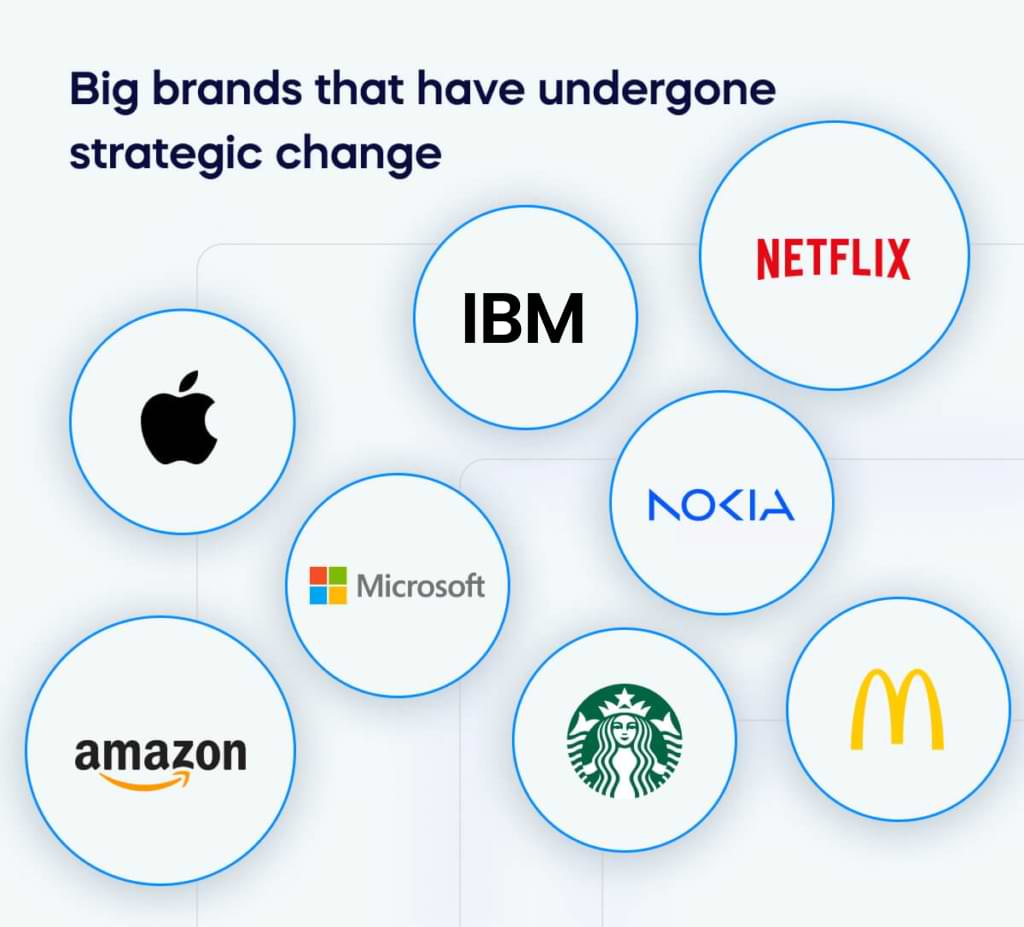
Several big brands have undergone significant strategic changes to adapt to evolving market conditions, technological advancements, or shifts in consumer behavior. Here are a few examples:
Apple
Apple is known for its transformative product launches, such as the iPod, iPhone, and iPad.
These innovations have marked shifts in the company’s strategy, moving from focusing on personal computers to a broader emphasis on mobile devices and services.
IBM
Originally a hardware-centric company, IBM underwent a major shift towards services and software in the 1990s.
This strategic change involved divesting hardware businesses like personal computers and focusing on consulting and enterprise software services.
Microsoft
Microsoft has shifted its focus from a predominantly software-centric model to a cloud-first, mobile-first strategy.
This includes the development of Azure cloud services, the acquisition of LinkedIn, and a broader emphasis on cloud computing and subscription-based services.
McDonald’s
McDonald’s has undergone several strategic changes over the years, including menu diversification, emphasizing healthier options, and implementing digital technology for orders and payment.
These changes aim to adapt to evolving consumer preferences and health trends.
Starbucks
Starbucks has evolved its strategy from being primarily a coffee retailer to a global consumer brand with a broader range of products and experiences.
This includes expanding its menu to include food items, introducing mobile ordering, and focusing on sustainability initiatives.
Netflix
Netflix started as a DVD rental-by-mail service and later shifted its business model to focus on streaming content.
This strategic change disrupted the traditional entertainment industry and positioned Netflix as a leading player in the digital streaming space.
Nokia
Nokia, once a dominant brand in the mobile phone market, struggled with the rise of smartphones.
The company underwent strategic changes, including partnerships and divestitures, to refocus on telecommunications infrastructure and technology.
Amazon
Amazon started as an online bookstore but has since evolved into a global e-commerce giant with diverse business lines, including cloud computing via Amazon Web Services, streaming services, and hardware products like Kindle and Echo.
How AI impacts strategic change
Artificial intelligence (AI) profoundly impacts strategic change for organizations across various industries. Here are several ways in which AI influences and contributes to strategic change:
Data-driven decision making
Insights derived from AI-driven analytics empower organizations to refine strategies, identify new opportunities, and respond effectively to changing market conditions.
Predictive analytics
Predictive analytics enables organizations to forecast demand, optimize supply chains, and make decisions that align with future market dynamics.
Automation of routine tasks
Human resources can be reallocated to strategic activities by automating routine tasks fostering innovation and higher-value work. This ultimately improves overall business performance.
Enhanced customer experience
Customization of products and services based on individual customer needs, facilitated by AI, increases customer satisfaction and loyalty and strategically differentiates organizations in the market.
Operational efficiency
Streamlining internal processes through AI implementation makes organizations more agile and adaptable to change, contributing to overall strategic goals.
Innovation and competitive edge
Organizations can leverage AI to drive innovation, develop cutting-edge products, and maintain a competitive edge in fast-evolving industries.
Personalized marketing
Optimization of marketing strategies through AI ensures organizations reach the right audience with the right message.
Supply chain optimization
Resilient and responsive supply chains are created through the use of AI, reducing costs, minimizing disruptions, and increasing overall supply chain efficiency.
Risk management
By strengthening risk management strategies, AI provides a more robust and resilient approach to uncertainties in the business environment.
Competitive advantage
As a cornerstone of organizational strategy, AI aids in differentiation within the market and maintains a competitive advantage over rivals.
Strategic change vs change management
Strategic change and change management are related concepts, but they refer to different aspects of the overall process when an organization undergoes significant changes.
In a nutshell, strategic change is about defining and executing a new direction or vision for the organization, while change management is about managing the process of transitioning from the current state to the desired future state to minimize disruptions and maximize success.
While strategic change sets the direction and goals, change management ensures that the organization successfully navigates the challenges associated with implementing those changes, with a particular emphasis on people and organizational culture.
Both are critical when an organization seeks to evolve and adapt to the dynamic business environment.
| Strategic change | Change management |
| Making significant shifts in goals, structures, processes, or the organization’s culture to better align with its long-term objectives. | Helps organizations plan, implement, and control changes to minimize resistance, maximize employee engagement, and ensure the successful adoption of new practices. |
| Primarily concerned with the big picture, addressing the “what” and “why” questions related to the organization’s purpose, goals, and positioning in the market. | Focuses on the “how” of change, addressing the “people” side of the transition, including communication, training, stakeholder engagement, and mitigating resistance to change. |
| Adopting a new business model Entering new markets Diversifying products or services Restructuring the organization Embracing digital transformation | Developing communication plans Providing training programs Creating feedback mechanisms Fostering a culture of openness and collaboration to support employees through the change process |
How to implement strategic change
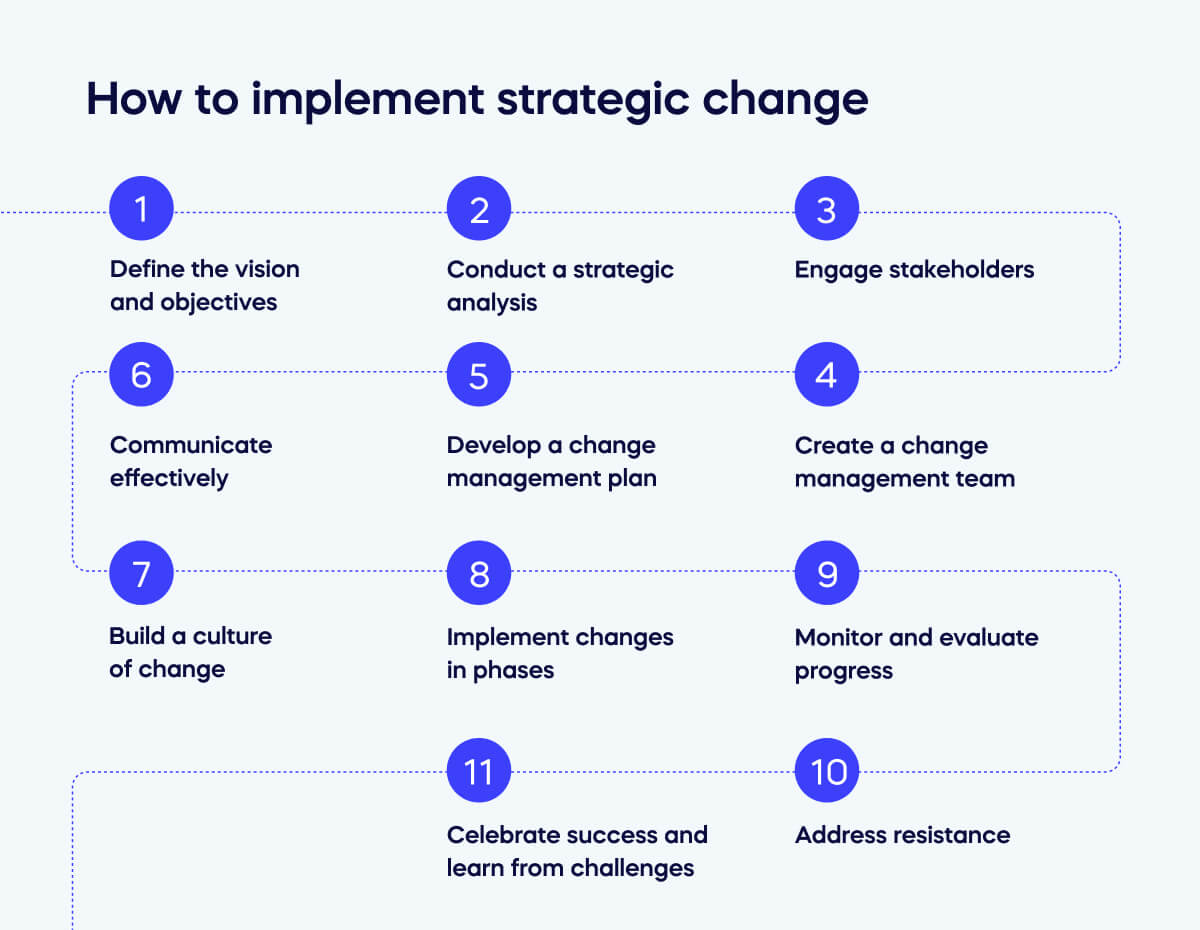
Implementing strategic change is a complex process that requires careful planning, effective communication, and strong leadership.
Here are the steps you should take:
Define the vision and objectives
- Clearly articulate the vision for the organization after the strategic change.
- Establish specific, measurable, achievable, relevant, and time-bound (SMART) objectives to guide the implementation process.
Conduct a strategic analysis
- Assess the internal and external factors influencing the organization.
- Identify strengths, weaknesses, opportunities, and threats (SWOT analysis).
- Understand the current market conditions, industry trends, and competitive landscape.
Engage stakeholders
- Communicate the need for change to all relevant stakeholders, including employees, customers, suppliers, and investors.
- Solicit input and feedback from key stakeholders to comprehensively understand potential challenges and opportunities.
Create a change management team
- Assemble a dedicated team responsible for overseeing and managing the change process.
- Include representatives from different departments to ensure diverse perspectives.
Develop a change management plan
- Outline the specific steps and actions required to implement the strategic change.
- Define roles and responsibilities within the change management team.
- Establish a timeline for key milestones and activities.
Communicate effectively
- Develop a comprehensive communication plan to keep all stakeholders informed.
- Be transparent about the reasons for the change, the expected outcomes, and how it aligns with the organization’s vision.
- Address concerns and provide regular updates throughout the process.
Build a culture of change
- Foster a culture that embraces innovation, learning, and adaptability.
- Provide training and development opportunities to help employees acquire the skills needed for the new direction.
- Recognize and reward behaviors that support the strategic change.
Allocate resources
- Ensure that the necessary financial, human, and technological resources are available to support the implementation.
- Allocate budgets and prioritize initiatives that align with the strategic change.
Implement changes in phases
- Break down the implementation into manageable phases.
- Pilot new processes or initiatives in specific areas before rolling them out organization-wide.
- Learn from each phase and make adjustments as needed.
Monitor and evaluate progress
- Establish key performance indicators (KPIs) to measure the success of the strategic change.
- Continuously monitor progress against the objectives and adjust the implementation plan as necessary.
- Solicit feedback from stakeholders to assess the impact of the changes on different aspects of the organization.
Address resistance
- Anticipate and address resistance to change through open communication and engagement.
- Provide forums for employees to express concerns and offer solutions.
- Implement strategies to overcome resistance and build support for the changes.
Celebrate success and learn from challenges
- Acknowledge and celebrate milestones and successes along the way.
- Analyze challenges and setbacks to extract lessons learned for future strategic initiatives.
- Use feedback and insights to continually refine and improve the organization’s change management capabilities.